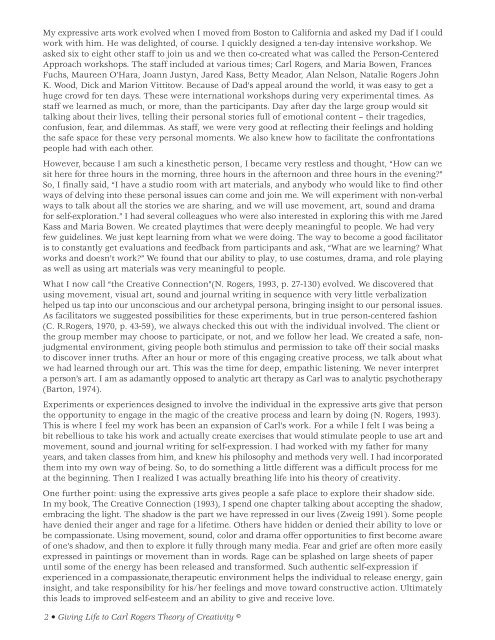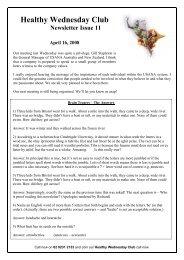Giving Life to Carl Rogers Theory of Creativity © Natalie Rogers, Ph ...
Giving Life to Carl Rogers Theory of Creativity © Natalie Rogers, Ph ...
Giving Life to Carl Rogers Theory of Creativity © Natalie Rogers, Ph ...
You also want an ePaper? Increase the reach of your titles
YUMPU automatically turns print PDFs into web optimized ePapers that Google loves.
My expressive arts work evolved when I moved from Bos<strong>to</strong>n <strong>to</strong> California and asked my Dad if I could<br />
work with him. He was delighted, <strong>of</strong> course. I quickly designed a ten-day intensive workshop. We<br />
asked six <strong>to</strong> eight other staff <strong>to</strong> join us and we then co-created what was called the Person-Centered<br />
Approach workshops. The staff included at various times; <strong>Carl</strong> <strong>Rogers</strong>, and Maria Bowen, Frances<br />
Fuchs, Maureen O’Hara, Joann Justyn, Jared Kass, Betty Meador, Alan Nelson, <strong>Natalie</strong> <strong>Rogers</strong> John<br />
K. Wood, Dick and Marion Vitti<strong>to</strong>w. Because <strong>of</strong> Dad’s appeal around the world, it was easy <strong>to</strong> get a<br />
huge crowd for ten days. These were international workshops during very experimental times. As<br />
staff we learned as much, or more, than the participants. Day after day the large group would sit<br />
talking about their lives, telling their personal s<strong>to</strong>ries full <strong>of</strong> emotional content – their tragedies,<br />
confusion, fear, and dilemmas. As staff, we were very good at reflecting their feelings and holding<br />
the safe space for these very personal moments. We also knew how <strong>to</strong> facilitate the confrontations<br />
people had with each other.<br />
However, because I am such a kinesthetic person, I became very restless and thought, “How can we<br />
sit here for three hours in the morning, three hours in the afternoon and three hours in the evening”<br />
So, I finally said, “I have a studio room with art materials, and anybody who would like <strong>to</strong> find other<br />
ways <strong>of</strong> delving in<strong>to</strong> these personal issues can come and join me. We will experiment with non-verbal<br />
ways <strong>to</strong> talk about all the s<strong>to</strong>ries we are sharing, and we will use movement, art, sound and drama<br />
for self-exploration.” I had several colleagues who were also interested in exploring this with me Jared<br />
Kass and Maria Bowen. We created playtimes that were deeply meaningful <strong>to</strong> people. We had very<br />
few guidelines. We just kept learning from what we were doing. The way <strong>to</strong> become a good facilita<strong>to</strong>r<br />
is <strong>to</strong> constantly get evaluations and feedback from participants and ask, “What are we learning What<br />
works and doesn’t work” We found that our ability <strong>to</strong> play, <strong>to</strong> use costumes, drama, and role playing<br />
as well as using art materials was very meaningful <strong>to</strong> people.<br />
What I now call “the Creative Connection”(N. <strong>Rogers</strong>, 1993, p. 27-130) evolved. We discovered that<br />
using movement, visual art, sound and journal writing in sequence with very little verbalization<br />
helped us tap in<strong>to</strong> our unconscious and our archetypal persona, bringing insight <strong>to</strong> our personal issues.<br />
As facilita<strong>to</strong>rs we suggested possibilities for these experiments, but in true person-centered fashion<br />
(C. R.<strong>Rogers</strong>, 1970, p. 43-59), we always checked this out with the individual involved. The client or<br />
the group member may choose <strong>to</strong> participate, or not, and we follow her lead. We created a safe, nonjudgmental<br />
environment, giving people both stimulus and permission <strong>to</strong> take <strong>of</strong>f their social masks<br />
<strong>to</strong> discover inner truths. After an hour or more <strong>of</strong> this engaging creative process, we talk about what<br />
we had learned through our art. This was the time for deep, empathic listening. We never interpret<br />
a person’s art. I am as adamantly opposed <strong>to</strong> analytic art therapy as <strong>Carl</strong> was <strong>to</strong> analytic psychotherapy<br />
(Bar<strong>to</strong>n, 1974).<br />
Experiments or experiences designed <strong>to</strong> involve the individual in the expressive arts give that person<br />
the opportunity <strong>to</strong> engage in the magic <strong>of</strong> the creative process and learn by doing (N. <strong>Rogers</strong>, 1993).<br />
This is where I feel my work has been an expansion <strong>of</strong> <strong>Carl</strong>’s work. For a while I felt I was being a<br />
bit rebellious <strong>to</strong> take his work and actually create exercises that would stimulate people <strong>to</strong> use art and<br />
movement, sound and journal writing for self-expression. I had worked with my father for many<br />
years, and taken classes from him, and knew his philosophy and methods very well. I had incorporated<br />
them in<strong>to</strong> my own way <strong>of</strong> being. So, <strong>to</strong> do something a little different was a difficult process for me<br />
at the beginning. Then I realized I was actually breathing life in<strong>to</strong> his theory <strong>of</strong> creativity.<br />
One further point: using the expressive arts gives people a safe place <strong>to</strong> explore their shadow side.<br />
In my book, The Creative Connection (1993), I spend one chapter talking about accepting the shadow,<br />
embracing the light. The shadow is the part we have repressed in our lives (Zweig 1991). Some people<br />
have denied their anger and rage for a lifetime. Others have hidden or denied their ability <strong>to</strong> love or<br />
be compassionate. Using movement, sound, color and drama <strong>of</strong>fer opportunities <strong>to</strong> first become aware<br />
<strong>of</strong> one’s shadow, and then <strong>to</strong> explore it fully through many media. Fear and grief are <strong>of</strong>ten more easily<br />
expressed in paintings or movement than in words. Rage can be splashed on large sheets <strong>of</strong> paper<br />
until some <strong>of</strong> the energy has been released and transformed. Such authentic self-expression if<br />
experienced in a compassionate,therapeutic environment helps the individual <strong>to</strong> release energy, gain<br />
insight, and take responsibility for his/her feelings and move <strong>to</strong>ward constructive action. Ultimately<br />
this leads <strong>to</strong> improved self-esteem and an ability <strong>to</strong> give and receive love.<br />
2 • <strong>Giving</strong> <strong>Life</strong> <strong>to</strong> <strong>Carl</strong> <strong>Rogers</strong> <strong>Theory</strong> <strong>of</strong> <strong>Creativity</strong> ©




